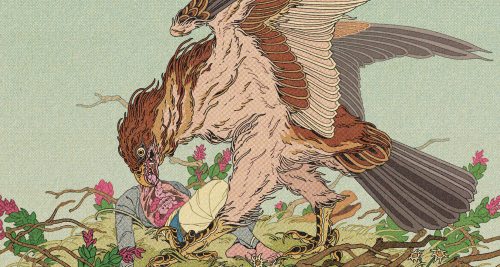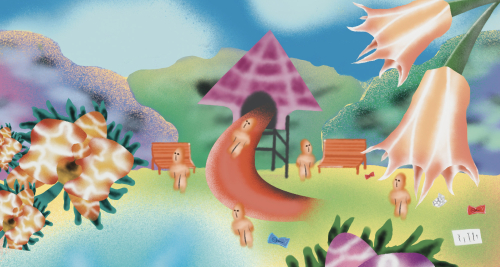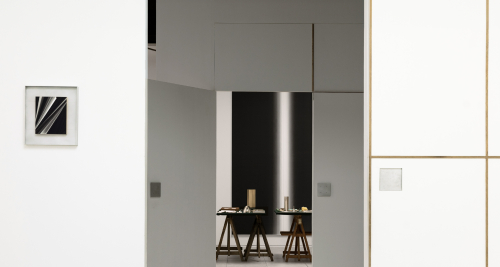Satrio Yudho: Exploring Pixel Art, Humanity, and Spirituality
A motion of white pixels forms a landscape of dystopia. Look closer into the blankness and there stands two-dimensional figures in constant collision: they destroy, disintegrate and drift amongst another. Over the past few years, Satrio Yudho, known as @yudho.xyz, has been exploring pixel art, encapsulated in a body of work called “Dirty Pixel.” This piece is an exercise of challenging the conventions of artistic practice through a raw, chaotic, and unrefined approach that involves merging and shifting pixels. In effect, the artwork is a witness of their constant motion, evoking depth and texture through its pointillistic noise. Yudho’s pixelated chaos mirrors the digital noise we encounter, particularly in our use of social media.
Despite his (current) embrace of experimentation, Yudho’s artistic journey began from a path of convention. He studied at ITB (Institute of Technology Bandung), where he majored in Fine Arts and specialised in painting. This period was marked by Yudho’s exploration of diverse themes through painting: “At that time, I experimented a lot and painted anything that ranged from playful and symbolic subjects to spiritual issues. I poured all of this (interest) into hundreds of canvases, forming a sort of constellation of works amongst each other,” he said. After graduating university, he continued his painting practice, but expanded into other avenues that included design, illustration, mural work, and photography. For nearly ten years, he continued this pace of moving across different creative practices and adopted many roles. At the end of 2021, he made a decision to return to the path of artistry. It was this decision that led him to begin and eventually commit to Web3 and NFTs.
His experience with traditional painting laid groundwork into Yudho’s foray into its digital counterpart, proven in his habitual production of dense details and layered compositions on large screens. For two years, he developed this practice, which was met with positive responses. However, when AI began to influence the visual culture of Web3, Yudho responded through adaptation– he did not want to create art through prompts, and sought to retain the (humane) act of drawing. This led to Yudho’s move into pixel art.

Several series amongst Yudho’s NFT pieces endured significant transformations, especially in technique and form. He began to focus on digital paintings and the process was of minimal restraint; as Yudho had been accustomed with the format of large canvases which he then transferred onto a digital medium. Yudho was able to play with their respective materialities – seamlessly tending to the materials’ ability to hold complexities, details, and compositions.
Yudho’s experimentation with pixel art led to his discovery of an entirely new terrain. He explained, “The shift from digital painting to pixel art isn’t really about changing styles, but about finding a different visual language that suited the different needs.” In his pixel art, the images are simpler in nature and its movements are more dynamic. Upon creation, Yudho is absorbed by each pixel, as it serves as a point of control. The process is inherently intimate, he continues: “Pixel art feels more like drawing with a pencil on paper. It’s simple, limited, but that’s exactly where I feel freer. I don’t need to build a complicated world—just one or two objects and a loop. In those limitations, I can be more honest and intuitive.”
Yudho’s inspirations are derived across many sources. He referenced his personal struggles, mental health issues, childhood game visuals, manga, internet culture, and the cult of AI. All of these merge as puzzle pieces connected to each other. In his works, main ideas often repeat themselves. He describes viewing his works as reading a constellation— a sequence of broken puzzles demanded to be pieced together.
For Yudho, creating art does not solely concern the final result. The process itself is of great importance. His greatest joy comes from the act of drawing, which begins from the placement of a pixel, or the pulling of a line, or the filling of color. These moments become ritual, synchronized with breath. In pixel art, Yudho finds meditation: each pixel marks a point of awareness. He no longer thinks about layered details or complex compositions, but focuses on the presence of each pixel. All of it stems from his urge to root in the essence of drawing.
From large canvases in his painting studio to the expansive digital screen and the small, intimate pixels, Yudho sees these materials as connected through drawing. This practice becomes Yudho’s way of understanding the world.
Although he has stepped into the world of Web3 and NFTs, Yudho does not restrict himself from exploring other art forms. For him, the digital and physical realms are not separate, they intersect and overlap. Pixels– in fact– are enmeshed into our everyday. He believes the physical and digital worlds are in constant flux, as they answer to each other’s rhythms and flow accordingly. This behaviour is reflected in Yudho’s treatment of how his works are displayed, which range from exhibitions to international music festivals. “For me, there is no strict boundary between the two (read: offline and online). My pixel art can appear on LED screens during concerts, and they can be printed as physical objects, or become part of an installation. The medium is just a vessel; what matters is how the work can continue to flow across spaces, both digital and physical,” he explained.
Until today, Yudho’s passion for experimentation persists. He is currently preparing an interactive project where the audience can experience his works immersively. “The challenge is how to present an experience that isn’t strictly visual but can also be felt,” he said.
He sees pixel art as a medium that tells the stories about the relationship between humans, technology, and spirituality. Pixels are a natural force in our lives, as we interact with them through our phones, TVs, cameras, and other devices. Recognising this, Yudho sees pixels as a perfect tool to narrate the relationship between humans and technology, illustrating the (inseparable) connection between creator and creation. In this interaction, we continuously shape and reshape each other.
“Technology can become a path for us to find meaning and spirituality in the modern world. But at the same time, we can become enslaved by what we have created. Technology can lead us toward enlightenment, yet humans often focus so much on progress that they overlook the negative impacts, which can be even bigger but remain invisible,” Yudho explained.
Today, Yudho’s pixel art lives across many spaces. It has appeared on concert screens, in print, or on NFT marketplaces. The context of their display may change, but the intention within each work remains. They are all born from a desire to tell the story of the relationship between humans and technology, whilst simultaneously serving as a space for Yudho to be in dialogue with himself.



















